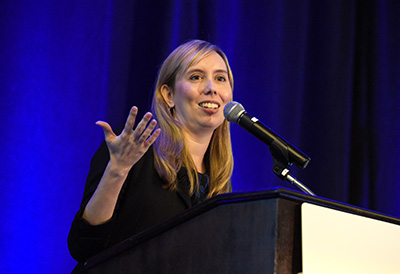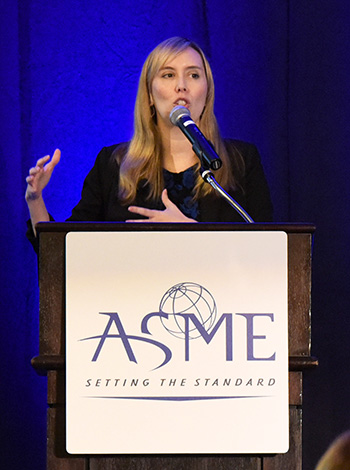Oscar Nominee Offers Annual Meeting Attendees an Inside Look at Making of Hidden Figures
Oscar Nominee Offers Annual Meeting Attendees an Inside Look at Making of Hidden Figures
June 30, 2107

The crowd at the Annual Meeting Luncheon in Newport Beach, Calif., on June 12 was treated to a first-hand account of the making of one of the biggest movies of the year from special guest speaker Allison Schroeder, the Oscar-nominated screenwriter of the hit motion picture Hidden Figures. The film, which was also nominated for the Best Picture Academy Award, depicts the struggles of a trio of African-American female mathematicians who supported NASA’s Project Mercury manned flight missions in the early 1960s.
During her entertaining and thought-provoking speech, Schroeder touched on a number of topics ranging from her childhood growing up near Cape Canaveral, to the racism and sexism faced by her film’s three real-life protagonists working in a field dominated by white men, to the importance of encouraging young people to engage in science, technology, engineering and math (STEM).
Raised on Florida’s Space Coast, Schroeder, who was nominated in the Best Adapted Screenplay category at this year’s Academy Awards, turned out to be a natural to pen the script for the story of NASA workers Katherine Johnson, Dorothy Vaughn and Mary Jackson. Schroeder became quite familiar with the space agency through her grandfather, who was an engineer on the Mercury space capsule, and her grandmother, who was one of the first women in mission control. “When I was growing up, you went to see grandma by going to the Vertical Assembly Building, and you went to see grandpa by playing on a Mercury capsule prototype,” she said. “And I thought this was normal.”

As a teenager, Schroeder took part in the NASA Unique Resident Tutoring for Up-and-Coming Replacement Engineers (NURTURE) program, where students with an interest in math and science spent their time on activities such as binary coding and building circuit boards. The program also gave Schroeder and her fellow students the rare opportunity of viewing a space shuttle up close — an experience that was a turning point in her life.
“They let us get within inches (of the shuttle) and inspect the heat shield,” she said. “They let us climb up the ladder and look inside. At that point, at 16, it was a very important lesson... That moment was so young in my life that I never again questioned whether or not I belonged in the room. Because I had been granted access and they told me I was good enough.”
That lesson was one shared by Katherine Johnson, the NASA mathematician at the center of the Hidden Figures story. Johnson, who was born Katherine Coleman in 1918, showed a keen aptitude for math beginning at a young age. “She skipped grades, she went to a gifted school, and she ended up going to college very early,” Schroeder said. “But she also had something very important for success and that was called ‘access.’” That access, according to Schroeder, was working summers as a personal maid at an exclusive resort, which brought Johnson in contact with members of high society — including a countess from France, who taught her how to speak French, and the brother of President Taft, who introduced her to Roman numerals.
“She took these lessons with her in life so that later when she ended up at NASA and John Glenn was trying to talk to her, she was unfazed,” Schroeder said. Through her experience at the resort, Johnson “was shown a world outside of her small one and she knew that she could be a part of it,” Schroeder continued.
Johnson, who served as an advisor for both the movie and the book on which it was based, was hired by NASA Langley Research Center later in life, after working as a teacher and raising a family. Johnson, who was portrayed by Taraji P. Henson in the film, was adamant on a couple of points as the movie was being developed, Schroeder said. First, she wanted the story to downplay the sexism and racism she experienced at the space agency. “That’s how she dealt with it,” Schroeder said. “She put on her blinders, pretended it wasn’t there, pushed against it when she needed to. But trust me when I say, it was there.” The film does depict a few of the indignities suffered by the women, however, including the existence of segregated bathrooms and coffee pots, and the casual sexist and racist behavior of their white co-workers.

She also asked that the movie widen its focus to include some of the other African American women working at NASA. To that end, Hidden Figures weaves in the stories of Johnson’s colleagues Dorothy Vaughn (played by Octavia Spencer), a woman “who endured 15 years of being a supervisor without the title,” according to Schroeder, and Mary Jackson (portrayed by Janelle Monáe), a mathematician who went on to become an aerospace engineer with the encouragement of her boss, engineer Kazimierz Czarnecki. After 30 years, Jackson passed up a promotion, instead taking a demotion to run NASA Langley’s equal opportunity office in order to “make sure that other women like her weren’t held back for so long,” Schroeder added.
The film, which Schroeder originally believed would be a “a little indie... that we thought maybe a million people might someday see,” went on to become more successful than the filmmakers — and Hollywood — ever dreamed it could be, grossing more than $230 million worldwide.
“The response to this movie has been amazing,” Schroder said. “We were number one in the box office and we beat out Rogue One, which shocked everyone in Hollywood, including us... It has been just spectacular.”
Aside from the remarkable popular success of the movie, Schroeder’s ultimate hope is that it encourages more young people, especially minorities and girls, to become interested in STEM. “We are going to run out of people qualified in STEM to be in the workforce in a decade,” she said. “Tech companies are getting scared. So people and women of color need to study it in school. I really hope it has inspired people to go into it.”
Schroeder then described to the audience a phone conversation she had with a friend that suggested the film may be doing just that. Schroeder said her friend was walking down the street one day with her daughter one day when the girl saw three African-American women approaching them. Upon seeing the women, the girl grabbed her mother’s hand, exclaiming, "Mommy! Mommy! Look... astronauts!"
“If that isn’t progress, I don’t know what is,” Schroeder said.




